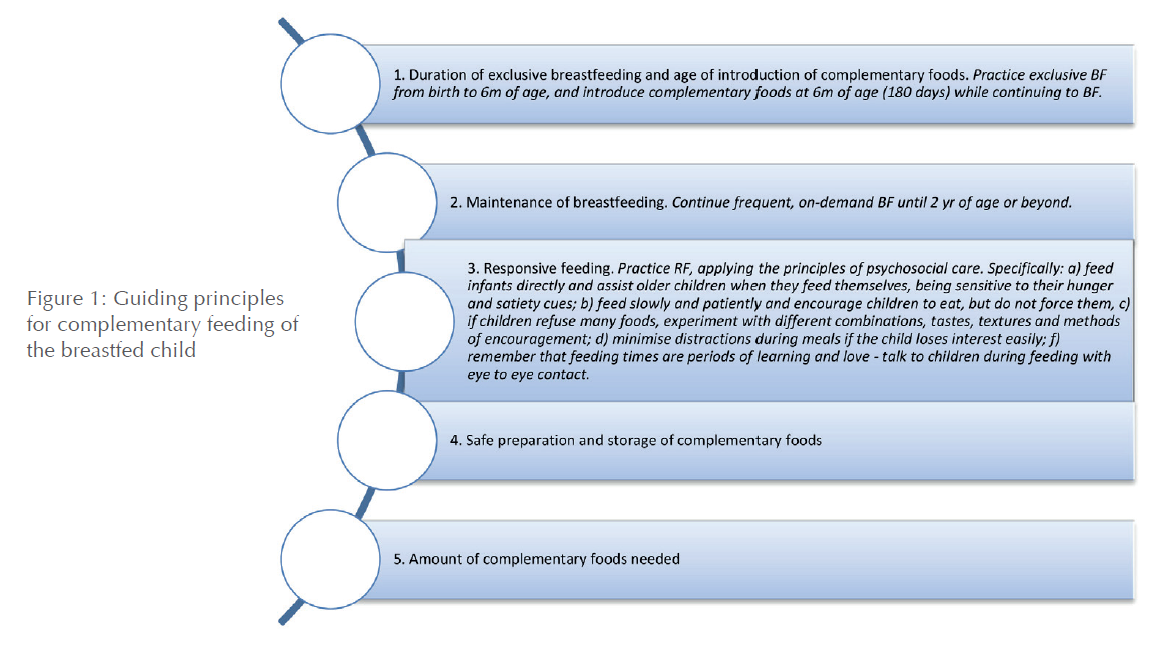Adopting a vegetables first approach to complementary feeding
Parents want to do the best for their children and guidance suggests introducing solids at six months (6m) after exclusive breastfeeding. In the early stages of complementary feeding (CF), parents vary in the approaches they use to encourage acceptance of solid foods. For example, in some cultures it is customary to pre-chew foods before offering to infants and in other cultures, foods such as vegetables are pureed then offered by spoon at the time of weaning. Recently babyled weaning has become a popular strategy where parents provide finger foods so that autonomy in eating is encouraged from the beginning. Weaning guidelines tend to focus on when to introduce solids however the Guiding Principles for Complementary Feeding published by the WHO1 contains specific guidance on how to feed as well as how much (See figure 1). Feeding responsively means being in touch with the ways in which infants communicate their needs, likes and dislikes. In order to achieve these parents must be able to identify, interpret and respond to signals of hunger, appetite and satiety as well as food preferences (see Hetherington, 2017).
Weaning with vegetables
Given that children struggle to consume sufficient vegetables due to their bitter taste or unusual texture, attempts to introduce vegetables in school age children is challenging2. In contrast, offering a variety of vegetables during CF promotes vegetable acceptance since this period presents a unique window of opportunity to experience new foods, specifically vegetables. At the age of 6m infants willing to try novel foods and are setting the foundations for healthy eating. Taste preferences established early on-track into later life. For example, offering a high variety of vegetables, compared to no or low vegetable variety during the first 10 days of CF increased acceptance and intake of vegetables which lasted up to six years later3.
Most mothers in the UK offer baby rice or fruit as a first food, most likely because they hope that this first experience will be enjoyable. Baby rice made with breastmilk or formula may form a bridge between milk feeding and solids, as fruit is naturally sweet. However, adopting a vegetables first approach is more likely to facilitate acceptance of these foods when it matters most – at the beginning of the flavour journey4.
In France, mothers report adding vegetable flavours to milk around the time of weaning. We tested this practice in a small sample of UK mothers by systematically adding vegetable flavours (purees of cooked vegetable) to milk for 12 days and then baby rice for 12 days. The result was an enhanced liking for vegetables and an increased intake compared to the control group. Infants given vegetables in this way demonstrated fewer negative facial expressions, more positive overt behaviours and a faster rate of eating vegetables during filmed lab visits5. Therefore, although mothers may be reluctant to use vegetables as a first food6, they might do this using a step-by-step introduction towards acceptance of the pure and distinctive flavour of vegetables. In conclusion, after the milk feeding phase, the period of complementary feeding provides the optimal opportunity to introduce a variety of vegetable flavours first and often to promote liking and intake to set the foundations of healthy eating.

References
- WHO, & Dewey, K. (2001). GUIDING PRINCIPLES FOR COMPLEMENTARY FEEDING OF THE BREASTFED CHILD. In Journal of Clinical Nutrition (pp. 1–37). https://doi. org/10.1017/S1368980011002485.
- Evans, C. E. L., Christian, M. S., Cleghorn, C. L., Greenwood, D. C., & Cade, J. E. (2012). Systematic review and meta-analysis of school-based interventions to improve daily fruit and vegetable intake in children aged 5 to 12 y. The American Journal of Clinical Nutrition, 96(4), 889–901. https://doi.org/10.3945/ajcn.111.030270.
- Maier-Nöth A, Schaal B, Leathwood P et al. (2016) The Lasting Influences of Early Food-Related Variety Experience: A Longitudinal Study of Vegetable Acceptance from 5 Months to 6 Years in Two Populations. PLoS ONE 11: e0151356.
- Schwartz C, Madrelle J, Vereijken CMJL et al. (2013) Complementary feeding and “donner les bases du gout” (providing the foundation of taste). A qualitative approach to understand weaning practices, attitudes and experiences by French mothers. Appetite 71: 321-331.
- Hetherington MM, Schwartz C, Madrelle J et al. (2015) A step-by-step introduction to vegetables at the beginning of complementary feeding. The effects of early and repeated exposure. Appetite 84: 280-290.
- Chambers, L., Hetherington, M., Cooke, L., Coulthard, H., Fewtrell, M., Emmett, P., … Stanner, S. (2016). Reaching consensus on a “vegetables first” approach to complementary feeding. Nutrition Bulletin, 41(3), 270–276. https://doi.org/10.1111/nbu.12220.
